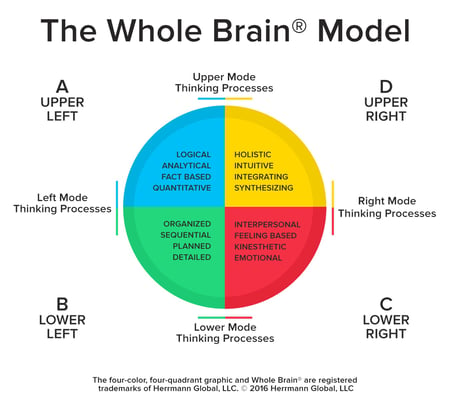
Have you ever been discussing an idea or explaining something to someone, and – no matter how eloquent you were – had the feeling that you weren’t being understood?
Have you ever planned the perfect thing to say to someone, only to have them look at you like you were speaking Latin?
Have you ever given a presentation you felt was really powerful and was sure to resonate with your prospect, but they didn’t see the value you were offering and react the way you thought they should?
Communication problems like these happen every day, and it doesn’t necessarily mean that you aren’t an effective communicator. The real issue could be a difference or a disconnection in your thinking preferences and those of the person(s) you’re speaking with.
4 types of thinking
Ned Herrmann, Ph.D., was a physicist, a musician, and a pioneer of brain research – now that’s an odd combination! When he was head of management education at GE in the 1970s, he began to research what science was saying about the brain and the way people think.
Using EEG, Ned discovered that there are four unique and distinctive thinking preferences humans use to process information and make decisions. His research has been validated by many scientists using surveys, PET scans, MRI, and EEGs.
Herrmann classified those unique processes into quadrants for easier discussion.

- The A quadrant is referred to as the “rational self.” It processes facts and data, does analysis, is logical and rational, quantifies, knows about money, and is realistic.
- The B quadrant is called the “safekeeping self” and is procedural, sequential, takes preventive action, is controlling, gets things done, is reliable, orderly or neat, and timely.
- The C quadrant is the “feeling self” and is where thinking connects with people. It is sensitive to others, likes to teach, is intuitive, supportive, emotional, and expressive.
- The D quadrant is referred to as the “experimental self.” It synthesizes information, integrates and sees the big picture, imagines, speculates, breaks rules, and wants to have fun.
People have different preferences for certain thinking styles that are based upon genetics, environment, and upbringing. Herrmann refers to a person’s preferred way of thinking as his or her “dominance.”
Herrmann used his extensive research findings to create an assessment to identify what a person’s dominance is and how much they practice thinking in each of the four quadrants. According to results from the Herrmann Brain Dominance Instrument®, 60% of the population is double-dominant (meaning their preferred thinking styles fall into any two of the quadrants), 30% is triple-dominant, 7% is single-dominant, and 3% is quadruple dominant.
For instance, someone who is double-dominant may prefer to approach a situation looking at the big picture and connecting with people (quadrants D and C). A triple-dominant person may want facts and processes and need an interpersonal connection to make a decision (quadrants A, B and C).
What does this have to do with winning sales?
Communication challenges occur when a person is thinking and communicating from one quadrant (preference) to a listener who is predominately thinking in another quadrant. The person doing the talking is presenting the kind of information that is important to him, but while what’s important to his listener is something entirely different.
In sales situations, this is a recipe for dead deals.
As a salesperson, your most challenging customers are probably the people who think in a quadrant that is diagonal from yours. For example, if you think in quadrant A (rational and facts) and your prospect thinks in quadrant C (feelings and expression), you will have difficulty establishing rapport with him or her. Your prospect thinks relationally and likes an emotional connection when communicating, whereas you like to discuss things in a logical sequence with facts. You may see your prospect as irrational, and your prospect may see you as cold and unfeeling. This kind of miscommunication doesn’t win sales.
A person who is dominant in the B quadrant (detailed, sequential, and process-oriented) has a similar challenge in trying to communicate with a D quadrant buyer who enjoys risk and likes the big picture. The buyer is thinking to himself, “This person is killing me with the details; why don’t they just get to the point?” When he asks the rep to get to the point, the rep thinks, “I am getting to the point with these next 10 slides!”
Sell according to your customers thinking style
The most successful sales reps use what Herrmann calls Whole Brain® Thinking to do two things:
- identify their customers’ thinking preferences so they can present the kind of information the customer will think is most important, and
- present it in a way the customer would prefer to hear it.
Reps who use the Whole Brain® Thinking approach are able to establish rapport and build trust quickly, shorten their sales cycles, and close more sales because they understand what appeals to people based on their thinking preferences.
One student at one a recent workshop shared his experience with implementing these practices:
"I like to get right to the bottom line without getting into too much detail. I always assumed my prospects were just like me, so I couldn't understand why I wasn't closing deals that should have been a no-brainer.
This class taught me that my prospects don't think the way I do - they like and require details. I started presenting more details and asking the questions I learned in this class, and I immediately started closing more deals. Bill taught me how to speak my customers' language, and now I can more quickly gain their trust and their business."
- Darryl White, Innovative Billing Solutions
Broader applications
Because of its power to improve communication and understanding between people, Whole Brain® Thinking is more than just an essential tool in the sales discussion. It is useful in any setting or application; from strategic planning and problem solving to designing web pages, writing proposals or job descriptions, and even personal relationships. My wife tells people that learning one another’s thinking preferences and communicating with them in mind literally saved our marriage!
If you are interested in learning more about Ned Herrmann and Whole Brain® Thinking, visit www.herrmannsolutions.com.
If you would like to discover your own thinking preferences, contact me at bill@billhartbizgrowth.com to take the Herrmann Brain Dominance Instrument®. You will get your personal thinking profile, a Whole Brain® workbook, and a one-on-one debrief.
If you’d like to apply these techniques to your sales process, check out my events page for upcoming workshops.

